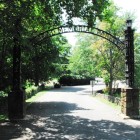Members of the New Canaan High School Science Team identified unusually high levels of phosphorus in Bristow Bird Sanctuary based on samples collected this past summer, according to a presentation the students gave last week. Natural levels of the chemical element should come in around .1 mg/L for streams with no reservoirs, yet tests conducted by a lab in June following a sample at Bristow came back at more than six times that amount, according to Andrew Yuang, a NCHS student who joined Science Team Co-Captain Kira Titova at the Dec. 8 Conservation Commission meeting, held in Town Hall and via videoconference.
Asked by Commission Chair what negative impact of high phosphorus could be, Yuang said that, similarly to nitrogen, high phosphorus that comes into a waterway—typically, from fertilizer—could lead to an overgrowth in algae which, in turn, reduces the amount of dissolved oxygen that aquatic life needs to breathe, an environmental condition called hypoxia. Schipper said, “It makes sense we are doing this test, because we are concerned about what is happening in our freshwater streams and ponds, but we’re also concerned about the downstream effect on Long Island Sound, and I would say i’m not surprised that there might be a very high reading because, as a regular visitor to Bristow and Bristow Pond, I’ve noticed the pond is often so heavy with plant life it feels like a snapping turtle could walk across the top of it, as opposed to swim underneath it. And so we actually have that kind of Petri dish of plant growth that you can see going up high and then fall off—it helps that the stream continually flushes water through there.




